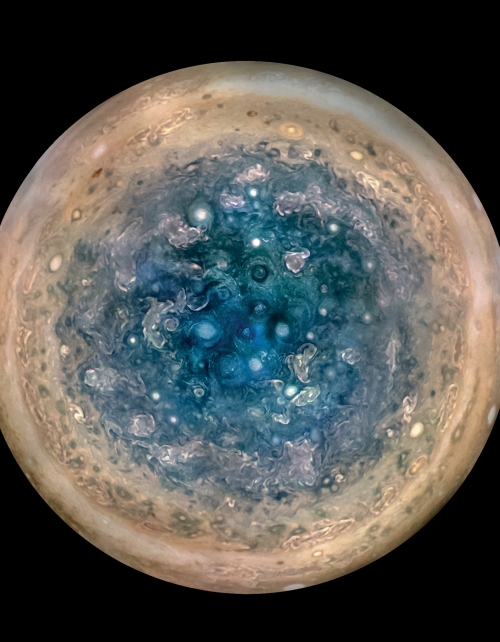Gerald Eichstädt put together this video of NASA’s Juno spacecraft making a flyby of perijove 6, the closest point it would come to Jupiter. The video is based on images Juno sent back to Earth. Those images were used to create textures that were then combined with trajectory data to reconstruct the flyby.
Tag: National Aeronautics and Space Administration
Jupiter’s South Pole Photographed by NASA’s Juno Spacecraft
Interesting photograph of Jupiter’s south pole photgraphed by NASA’s Juno spacecraft.
According to NASA, those whorl-like structures are storms the size of the entire Earth,
Among the findings that challenge assumptions are those provided by Juno’s imager, JunoCam. The images show both of Jupiter’s poles are covered in Earth-sized swirling storms that are densely clustered and rubbing together.
“We’re puzzled as to how they could be formed, how stable the configuration is, and why Jupiter’s north pole doesn’t look like the south pole,” said Bolton. “We’re questioning whether this is a dynamic system, and are we seeing just one stage, and over the next year, we’re going to watch it disappear, or is this a stable configuration and these storms are circulating around one another?”
Someone At NASA Has a Sense of Humor
My wife IMed me a link to this NASA page about tonight’s total lunar eclipse. NASA notes that,
According to folklore, October’s full moon is called the “Hunter’s Moon” or sometimes the “Blood Moon.” It gets its name from hunters who tracked and killed their prey by autumn moonlight, stockpiling food for the winter ahead. You can picture them: silent figures padding through the forest, the moon overhead, pale as a corpse, its cold light betraying the creatures of the wood.
NASA then goes into detail about the lunar eclipse, when the moon will enter the Earth’s shadow, and why the moon appears to be red. And then they add this note,
Warning: While you’re staring at the sky, you might hear footsteps among the trees, the twang of a bow, a desperate scurry to shelter. That’s just your imagination.
Source:
Total Lunar Eclipse. NASA, October 13, 2004.
